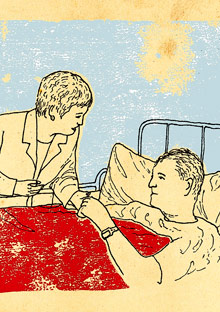
Illustration: Roderick Mills
Not everyone goes to their deathbed surrounded by loved ones— which is why an Oregon nurse enlisted an entire hospital (everyone from kitchen workers to carpenters) to make sure that no one dies alone.
At a large medical center in the Northwest, while making her rounds, a veteran nurse checks on a frail, elderly man who is near death. "Will you stay with me?" the man asks, his voice barely audible. "Of course," she says, meaning it. "As soon as I check on my other patients."But tending to others takes the next hour and a half, and by the time the nurse returns to the man's room, he is dead. She consoles herself with the knowledge that he was very old and obviously failing, that there were orders to not resuscitate him, that even if she had returned more quickly she could have done nothing. Still, she is troubled. She feels that she has failed, not just as a nurse but as a human being. It was okay for him to die, she thinks—it was his time—but it was not okay for him to die alone.
Looking back on that night, the nurse, whose name is Sandra Clarke, says, "I was overcome with guilt and frustration. I didn't know what to do. I just knew something had to be done." Meeting Clarke, it's hard to imagine that anything could unsettle her for long. Almost exhaustingly energetic, she has an animated face framed by dazzling silver hair, the tips of which she dyes jet-black. She is the kind of person who makes her own weather, a category-defier who quotes Mother Teresa one minute and recounts the plot of a B-grade horror movie the next. The kind of woman who turns a wrenching moment into an ambitious, life-altering plan.
That plan is a program called No One Dies Alone (NODA). Almost single-handedly created by Clarke, it is today radicalizing end-of-life care in hospitals by making volunteers available to comfort dying patients in their final hours. The program enlists hospital employees from every department—from kitchen workers to carpenters, medical transcriptionists to maintenance men—to sit with dying patients who are on their own.
Launched in November 2001 at Sacred Heart Medical Center in Eugene, Oregon (where as many as 200 volunteers are routinely on call, dispatched to the hospital at all hours by a rotating group of phone coordinators), Clarke's program now operates in hospitals from Alaska to New York, as well as in Singapore and Japan. Clarke, who won a Circle of Excellence Award from a national nursing association in 2004, has written a No One Dies Alone manual and distributed it to more than 400 hospitals, hospices, and AIDS care facilities worldwide. Her all-volunteer program operates with no funding except a small grant to subsidize the printing of the manual.
Although many dying patients have family or friends available, a significant number do not—from "elder orphans" (Clarke's term for those who have outlived their families), to people whose geographically or emotionally distant relatives are not able to be present, to the occasional stricken traveler. One 40-year-old man did not want to die in the presence of his wife and young children—but also did not want to die alone.
NODA's compassionate companions, as the volunteers are called, sit at the bedside of the dying, holding a hand or stroking an arm. Some talk or read aloud—everything from essays in Chicken Soup for the Soul to articles in Field & Stream. Others play CDs. The shared time is intense but not always somber. During one NODA vigil, a volunteer found herself singing along, at 3 A.M., to Gilbert and Sullivan operettas. Another volunteer traded fishing stories with a 96-year-old man during the last hours of his life. Whatever the volunteers do in these hours, they offer the most valuable gift: a dignified death. In return they sometimes experience something profound.
Jim Clark (no relation to Sandra) is a 61-year-old maintenance man at Sacred Heart whose work ranges from repairing beds to unclogging toilets; he's an amateur gunsmith and an NRA-certified pistol instructor. He heard about NODA from a coworker not long after his own father died, with Clark by his side. "It matters how you go," Clark says. "I would never have wanted my father to go alone." Since he put his name on the list, Clark has participated in more than two dozen vigils and has been with six people at the moment of their deaths. He remembers sitting in a chair by one woman's bedside listening to her labored end-of-life breathing. "I told her there were friends waiting for her on the other side. I told her to relax. And I think she did. I think I helped." Clark pauses and swallows. "You have no idea what that means to me."
Another volunteer, a 50-year-old receptionist named Vicki Wiederhold, recalls being able to calm an agitated patient. "After a while, she seemed to fall asleep or slip into a coma," Wiederhold remembers. "Then at one point, she opened her eyes, looked at me, and said, 'Thank you, Vicki.'" Four minutes later, the patient was dead. "To know that I can help bring a moment of peace like that is everything," Wiederhold says.
Seven years ago, when she roughed out a proposal at her kitchen table, Sandra Clarke had no idea her modest plan would become an international program—and little inkling that NODA would have such an effect on volunteers. "It is all
so simple," she says. "Anyone with a heart can do it." Lauren Kessler's latest book is Dancing with Rose: Finding Life in the Land of Alzheimer's (Viking). For more about No One Dies Alone, go to www.peacehealth.org/oregon/noonediesalone.htm.




